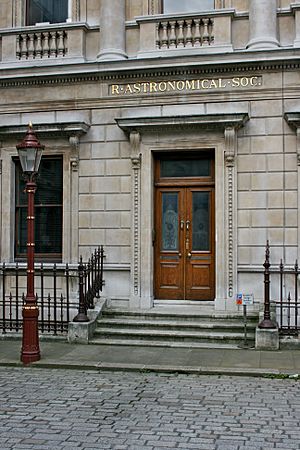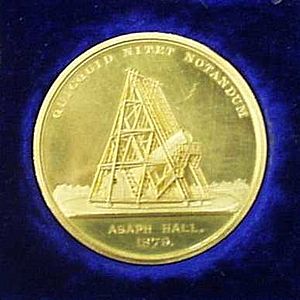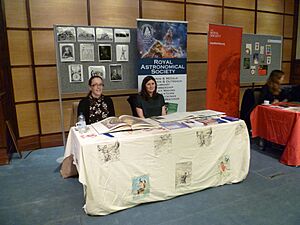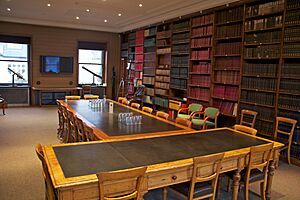Royal Astronomical Society facts for kids
 |
|

Entrance to the Royal Astronomical Society at Burlington House, London
|
|
| Abbreviation | RAS |
|---|---|
| Formation | 10 March 1820 |
| Type | NGO, learned society |
| Legal status | Registered charity |
| Purpose | To promote the sciences of astronomy & geophysics |
|
Professional title
|
Fellow of the Royal Astronomical Society (FRAS) |
| Headquarters | Burlington House |
| Location | |
| King Charles III | |
|
President
|
Mike Lockwood |
|
Executive Director
|
Philip Diamond |
|
Formerly called
|
Astronomical Society of London (1820–31) |
The Royal Astronomical Society (RAS) is a special group that helps people learn about and study astronomy. This includes planets, stars, and space. They also focus on geophysics, which is the study of Earth's physical processes. The RAS is based in London, England.
This society has over 4,000 members. These members are called 'Fellows'. Most Fellows are professional scientists or students studying these subjects. About one-fourth of them live outside the United Kingdom.
The RAS holds science meetings every month in London. They also have a big yearly meeting called the National Astronomy Meeting. This meeting happens in different places across the British Isles. The society publishes important science magazines and journals. These include Monthly Notices of the Royal Astronomical Society and Astronomy & Geophysics.
The RAS has a large library filled with books about space and Earth science. They also teach the public about astronomy. They give advice to the UK government on how to teach astronomy in schools. Each year, the RAS gives out awards and prizes for great achievements in astronomy and geophysics. Their top award is the Gold Medal of the Royal Astronomical Society.
Contents
A Look Back: The RAS Story
The Royal Astronomical Society started in 1820. It was first called the Astronomical Society of London. Its main goal was to support people studying the stars and planets. Back then, most members were not professional scientists. They were often wealthy people who loved astronomy as a hobby.
In 1831, the society received a special permission from King William IV. This permission, called a Royal Charter, changed its name to the Royal Astronomical Society.
In 1846, another old group, the Spitalfields Mathematical Society, joined the RAS. This group had started way back in 1717. Its members became free lifetime members of the RAS. In return, the RAS received their large library collection.
Women in Astronomy: A New Chapter
For many years, women were not allowed to become full members, or Fellows, of the RAS. However, some amazing women were made honorary members. These included Anne Sheepshanks, Lady Margaret Lindsay Huggins, Agnes Clerke, Annie Jump Cannon, and Williamina Fleming.
In 1886, Isis Pogson was the first woman to try to become a Fellow. Her father and two other Fellows nominated her. But lawyers said that the society's rules only mentioned "he" for Fellows. So, her nomination was withdrawn.
Things changed in 1915. A new rule was added that allowed women to become Fellows. On January 14, 1916, five women made history. Mary Adela Blagg, Ella K Church, A Grace Cook, Irene Elizabeth Toye Warner, and Fiammetta Wilson were the first women elected as Fellows of the RAS.
Who Can Join the RAS?
Becoming a Fellow
Full members of the RAS are called Fellows. They can use the letters FRAS after their names. Anyone over 18 can become a Fellow if the society accepts them. You don't need special degrees to join. This is because the society started before there were many professional astronomers.
Today, about three-quarters of Fellows are professional astronomers or geophysicists. Many others are students working on their PhDs in these fields. There are also advanced amateur astronomers and people who study the history of science. The society helps astronomers and geophysicists in the UK. Fellows can even apply to become a Chartered Scientist through the society. The number of Fellows went over 3,000 in 2003.
Friends of the RAS
In 2009, the RAS started a new group called "Friends of the RAS." This group is for anyone interested in astronomy and geophysics. You don't need to be a professional scientist or have special knowledge. Friends of the RAS can enjoy talks, visits, and social events.
Exciting Meetings and Events
The Royal Astronomical Society holds many different types of meetings.
The biggest meeting each year is the National Astronomy Meeting. This is a large conference for professional astronomers. It lasts for 4 to 5 days, usually at a university in the UK. Hundreds of astronomers attend this event every spring or early summer.
The RAS also has smaller "highlight" meetings. These meetings feature talks about new research in astronomy and geophysics. Often, the speakers are winners of the society's awards. These talks are usually held in Burlington House in London. They happen on the second Friday of each month from October to May. The talks are easy to understand for most astronomers and geophysicists. Anyone can attend for free, not just members.
Special discussion meetings happen on the same day as the highlight meetings. These are for professional scientists in specific research areas. They allow many speakers to share new findings. Usually, two discussion meetings happen at the same time. One is about astronomy, and the other is about geophysics. They take place before the highlight meeting. Members can attend for free, but non-members pay a small fee.
The RAS also offers public lectures for everyone. These talks are for people who are not scientists. They usually happen once a month on Tuesdays. The same talk is given twice: once at lunchtime and once in the early evening. These lectures are free, but you might need to book in advance for popular ones.
Sometimes, the society hosts or helps with meetings in other parts of the UK. They often work with other science groups and universities.
A Treasure Trove of Knowledge: The Library
The Royal Astronomical Society has an amazing collection of books and journals. It's one of the best libraries for astronomy and geophysics. It has more than 10,000 books, from popular science to detailed research papers. The library also gets about 300 new magazines and journals each year.
Its collection of old and rare astronomy books is very special. It's one of the best in the UK. The RAS library is a huge help for the society's members. It also helps many other astronomers, geophysicists, and history experts.
Helping Students Learn: Education
The society helps teach the public about astronomy. They have special pages online for students, teachers, and the media. The RAS also advises on UK school exams, like GCSEs and A Levels.
Special Groups They Work With
The RAS supports several special groups. Many of these groups work in areas that combine different sciences. The RAS often partners with other societies for these groups:
- The Astrobiology Society of Britain (with the NASA Astrobiology Institute)
- The Astroparticle Physics Group (with the Institute of Physics)
- The Astrophysical Chemistry Group (with the Royal Society of Chemistry)
- The British Geophysical Association (with the Geological Society of London)
- The Magnetosphere Ionosphere and Solar-Terrestrial group (MIST)
- The UK Planetary Forum
- The UK Solar Physics group
Leaders of the RAS: Presidents
The first President of the Royal Astronomical Society was William Herschel. He was a very famous astronomer. Since then, many important astronomers have held this position. The President usually serves for two years. Some have served for shorter times due to health reasons.
Francis Baily and George Airy were elected President four times each. Baily served for eight years in total, which is a record. Since 1876, no one has served for more than two years in total.
The current president is Mike Lockwood. He started his term in May 2024. His term is for two years.
Celebrating Achievements: Awards and Prizes

The highest award from the Royal Astronomical Society is its Gold Medal. This medal is given for amazing lifetime achievements. Some famous people who received it include Albert Einstein in 1926 and Stephen Hawking in 1985.
Other awards are for specific topics in astronomy or geophysics. These include the Eddington Medal, the Herschel Medal, the Chapman Medal, and the Price Medal. There are also awards for teaching (Patrick Moore Medal), public outreach (Annie Maunder Medal), and making new instruments (Jackson-Gwilt Medal). The Agnes Mary Clerke Medal is for studying the history of science.
The society also has special lectures named after famous scientists. These include the Harold Jeffreys Lectureship in geophysics and the George Darwin Lectureship in astronomy. Each year, the society gives free lifetime memberships to important researchers who live outside the UK. These are called honorary fellowships.
More Things the RAS Does
The society has its offices at Burlington House in London. Fellows and other interested people can use the library and meeting rooms there. The RAS also speaks for astronomers and geophysicists to the UK government. They have a press office that shares news about science with the media and the public. The society gives money to support good projects in astronomy and geophysics. They also help manage the Paneth Trust.
See also
 In Spanish: Real Sociedad Astronómica para niños
In Spanish: Real Sociedad Astronómica para niños
- National Astronomy Week (NAW)
- List of astronomical societies
- List of geoscience organizations



